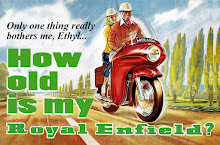I've learned a little about old motorcycles since acquiring my far from modern Royal Enfield Bullet. But I'm still not much good at identifying old motorcycles.
When "Enzo" asked me to identify the crusty, rusty V-twin motorcycle shown here, I posted an item with several pictures, expecting that some reader would instantly recognize it as some garden variety model known to everyone but me.
It wasn't that easy and, in fact, it turns out that this very motorcycle has frustrated some real experts.
Ever game, Jorge Pullin, who blogs at My Royal Enfields, did the research and concluded that this is a 1930s motorcycle built especially for the Spanish market. Read Jorge's full explanation.
I wrote to Paul d'Orléans, a true expert and the author of The Vintagent blog, asking for help. He was kind enough to comment that Jorge may be correct. Congratulations, Jorge.
Paul noted that he had earlier posted this motorcycle on his Vintagent Facebook page asking for help identifying it. I looked up The Vintagent on Facebook and was fascinated by the discussion there. You get a real feel for the issues involved in identification. Here's a taste of what's being said:
Pete Young: Right hand sidecar mounts...
T.Duke Stuedell: Vintage Husqvarna?
Pete Young: Husky's looked kinda like this. But the hand shifter was in the center of the petrol tank.
Theodore Smart: 1930-1933 Triumph RR 750, 2-cyl. 741cc 16hp, one of the German ones.
John Beechell: Shuttle-worth snap.
Fred Rozario: From the right hand side view, the engine looks a lot like a 1918-1920 Indian Powerplus. If only I could see more of the transmission...
Seth Jaramus: I think Amy's right. Appears to be a early '30s NSU V-twin. Seems like an Amal-Fischer carb on the LHS of the bike and standard German Steib-type sidehack lugs on the right. I think Sweden was a RHD country in the '30s so the lugs would have been on the left of the bike if it were a Husky. I am not 100 per cent sure, though.
Fred Rozario: Just reviewed my pictures from the Deutsches Zweirad NSU Museum in Neckarsulm Germany (visited earlier this summer). I saw no early-30s NSU V-twin engines, period, in the museum, but perhaps I missed one.
Philippe Murat: Russian PMZ "A-750" (or "Podolski")???
The Vintagent: The machine is in Spain. Don't be fooled by a saddle tank; the engine looks 1926-30. I'll post more photos... Theodore, that's not an MAG engine, so I don't think it's a German Triumph, unless they also used JAP engines?
Buzz Kanter: A ratty flatty?
Eric Halais: It has some Crocker style there.
Magnus P Matthis: Sweden was was a LHD country until 1967. From then on it's up to the driver! ;)
Tom Sappington: Engine looks like JAP or a close knock-off; pre- Ricardo heads. 1920s? Magneto/dyno drive off the primary is new to me, but looks neatly done.
Trent Reker: It is a JAP motor. The front end looks like it's off a Royal Enfield from the mid to late 1920s. The tank isn't original but I'm going to guess the bike used to be a Royal Enfield Model 180.
The Vintagent: Trent here's a 1928 Royal Enfield V-twin; different chassis:
Trent Reker: So it's not a JAP in an Enfield?
Tom Sappington: Rear frame bend in bottom tube reminds me of a Dresch; unusual.
Keith Marshall: Errrrrrrrrrrm!
Hop on The Vintagent Facebook page if you'd like to weigh in.
Will someone please let me know how it all turns out?
Where in Färila?
-
(I decided to turn this into the regular Christmas post for the blog. Even
if it repeats year after year, who can tire of seeing this?)
Now you know the...


































No comments:
Post a Comment